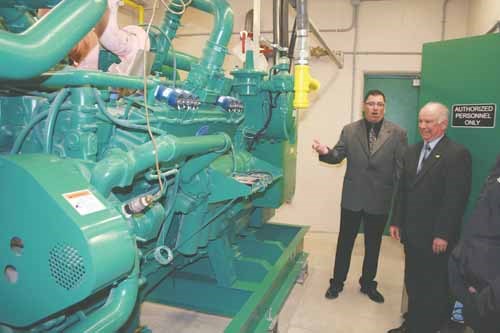The Queen Street Water Treatment Plant was officially opened Friday, although the facility has been fully operational for months.
"This project is a long time coming," said Yorkton Mayor James Wilson, adding the facility "is the largest municipal project in Yorkton history."
Wilson said in 2004 it was recognized the existing water treatment network "could no longer meet the growing needs of our community.
"We needed a new high out-put facility."
The plant took months of planning explained Michael Buchholzer, Director of Environmental Services with the City.
"To create the frame work for the plan, long term water quality objectives had to be established. To help create those objectives, a survey was distributed to the residents of Yorkton," he said.
"The level of response was remarkable. It indicated that many residents were interested in their water utility."
Buchholzer said the plant was actually built in phases.
"To maximize government grants, the construction of the water treatment plant was built in phases or contracts. Each contract received federal and provincial funding," he said. "City funding comes from the waterworks utility which is supported by your monthly water bills."
Funding for the project has come from federal and provincial grants, and from the city through its waterworks utility.
The government of Canada and Saskatchewan each contributed $7.36 million to the project, the City of Yorkton $18.3 million. Federal and provincial funding was provided through the Canada-Saskatchewan Municipal Rural Infrastructure Fund and the Building Canada Fund Communities Component.
In terms of actually treating the water Buchholzer said the process is rather straight forward. The plant draws water from a series of wells (Yorkton is the largest urban centre in the province that relies solely on ground water).
"The process is very simple, well water enters the facility from 16 wells located within a 10 kilometre radius of the water treatment plant," he said. "This untreated water or 'raw water' is then aerated to oxidize the two most commonly found minerals in drinking water, iron and manganese. Oxidation is the conversion of the mineral to a more readily removable form."
To treat the water two commonly used chemicals in water treatment, chlorine and potassium permanganate are used.
"The untreated water passes through large holding tanks, where we add chlorine," said Buchholzer. "This chemical is used for disinfection of our drinking water and helps oxidize the manganese. We then add potassium permanganate, this also helps with the oxidization process
"The plant has two identical treatment trains or systems. This redundancy allows for maintenance on the system while continuing to meet demand."
When completed, the project site will also include substantial green space for public enjoyment as well as six new multi-purpose sports fields. At maximum capacity the plant can treat 22,000 cubic metres (22 million litres) of water per day.
"To remove iron and manganese particles from the treatment plant system, we need to backwash or flush the filters," said Buchholzer. "In our old water treatment facilities, all backwash water was treated at the Wastewater treatment plant. If this plant was to operate under the same theory, we would have to construct a sewage pipeline and a lift station, to convey the backwash water to the sewage treatment plant. The capitol cost of such a project was estimated at $3 million
"To avoid overloading our sewage piping system and wastewater facility, the department created an environmentally friendly treatment system.
We incorporated a series of settling ponds that will overflow and naturally recharge the ground water aquifer saving the taxpayers approximately $6.3 million in operational costs, over the life of the water plant, for a total savings of approximately $10 million."
The water treatment plant can produce 22,000,000 litres of water per day.
The Queen Street Water Treatment Plant reservoir has a capacity of 18,000,000 litres.
Previously, the City of Yorkton had four antiquated water treatment plants scattered throughout the city. Each well was designated to one of the older water treatment plants and could not be directed to any other treatment facility. Our new plant accepts water from all of our wells. This gives us the versatility to operate any well at any given time," said Buchholzer.



